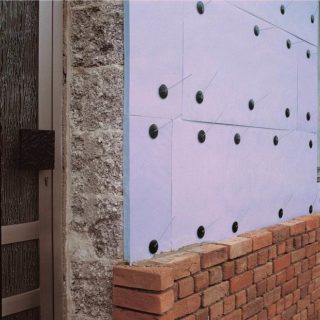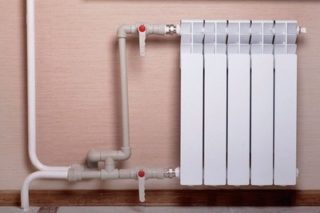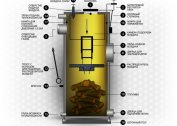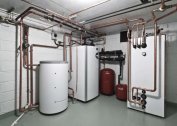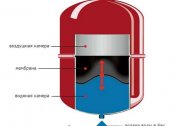Climatic conditions in most of Russia require a reliable and efficient heating system for comfortable living in a house or apartment. Despite the variety of alternative methods of heating the room, for example, using a warm plinth or infrared heaters, the most popular are traditional heating radiators, which are installed under the windows. In order for the heat transfer to meet the needs of consumers and ensure a normal temperature in winter, it is necessary to calculate the number of sections of heating radiators, taking into account a number of specific criteria, including the area of the room and heat loss.
Calculation recommendations and basic requirements
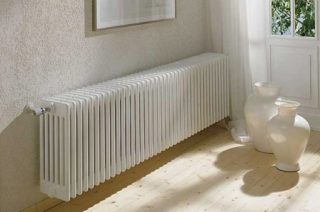
Do not buy radiators with a large margin or at random. If they are not powerful enough, maintaining a comfortable indoor temperature in winter will not work, too powerful ones will lead to high heating costs.
Mainly to consider:
- area and height of the room;
- material of which the radiator is made;
- maximum number of sections;
- heat transfer of one section.
One section of a cast-iron radiator provides heat transfer of 160 W, if this is not enough, the amount can be increased. They are durable, not subject to corrosion, keep heat. However, fragile, do not withstand sharp point hits.
The heat transfer of aluminum radiators is about 200 watts, they can withstand temperatures of about 100 ° C and pressure from 6 to 16 bar, but are susceptible to oxygen corrosion. This problem is solved by anodized oxidation.
Bimetallic inside are made of steel, and on top of aluminum, due to which they combine the positive properties of both metals: high wear resistance and heat transfer.
Steel - the most affordable, lightweight and quite attractive in design. However, they quickly cool down, rust and cannot withstand water hammer.
A summary of the different types of radiators is presented in the table:
| Cast iron | Steel (panel) | Aluminum | Anodized Aluminum | Bimetal | |
| The power of one section at a coolant temperature of 70 and a height of 50 cm, W | 160 | 120 | 175-200 | 216,3 | 200 |
| Maximum coolant temperature, ° C | 130 | 110-120 | 110 | 110 | 110-130 |
| Pressure, atm | 9 | 8-12 | 6-16 | 6-16 | 16-35 |
When choosing a radiator, be sure to consider what material it is made of. This parameter has a significant effect on the calculations. In addition, you need to pay attention to the minimum heat transfer, since the maximum heat transfer is possible only at the maximum temperature of the coolant, and this is extremely rare.
How to calculate the number of sections of heating radiators
The basic value for calculating the required power of radiators is the area of the room or its volume. But simple formulas are used to calculate when the room has no features. In other cases, the formula is much more complicated.
Per square meter
If the room has a standard ceiling height of 2.7 m, and also does not differ in architectural features - large glazing area, high ceilings, you can use a simple formula in which only the area is taken into account:
Q = S × 100.
S in this formula is the area of the room, which is usually known in advance from the documents. If there is no such data, it is easy to calculate by multiplying the length of the room by the width. 100 - the number of watts that are required to heat 1 m2 of the room. Q - heat transfer - the value obtained as a result of multiplication.
The power of a non-separable radiator is indicated in the documents. You should choose a device whose power is slightly higher than the calculated one. Such a formula is suitable if the radiator power is calculated for a room in a multi-storey building with a ceiling height of 2.65. Let the area of this room be 20 m2, then the battery power is 20 × 100 or 2000 watts. If the room has a balcony, the value is increased by another 20%.
If you want to know how many sections of batteries you need per square meter, the resulting value is divided by the power of one section and get the required number of sections for efficient heating of a particular room. Using the already calculated value to determine the number of sections of a cast-iron heating battery, you get 2000/160 = 12.5 sections. The number is usually rounded up, which means that a 13-section cast-iron radiator is needed.
In rooms where heat losses are not large, it is permissible to round down. In the kitchen, for example, a stove works, which will be an additional means of heating.
The table shows the ready-made values for standard rooms of various sizes:
| Area, m2 | 5-6 | 7-9 | 10-12 | 12-14 | 15-17 | 18-19 | 20-23 | 24-27 |
| Power, W | 500 | 750 | 1000 | 1250 | 1500 | 1750 | 2000 | 2500 |
By volume
If the ceilings are significantly higher than 2.7 m, for example 3.5 m, you should use in the calculations a formula that takes into account this indicator in addition to the area of the room. It was determined that for heating 1 m3 in a prefabricated house, 34 W is required, in a brick house - 41 W, so the formula takes the following form:
Q = S × h × 41 (34)
Instead h substitute the height of the ceilings in meters, instead S - area, similar to the previous formula. Q - the required power of the heating radiator. Suppose that you need to perform a calculation for a room of 20 m2 with a ceiling height of 3.5 m in a panel house. We get: 20 × 3.5 × 34 = 2380 watts. Divide the power of 160 W to calculate the number of sections of the heating radiator: 2380/160 = 14.875. A 15-cell battery is required.
Non-standard room
More complex calculations, taking into account secondary parameters, are necessary if the walls of the room are in contact with the street, the windows face the north side or the walls are not well insulated. Also, many other parameters take into account the formula of the form:
Q = S × 100 × A × B × C × D × E × F × G × H × I × J
The foundation remains the same, it S × 100. Other components of the formula are up and down correction factors, depending on a number of features of the room.
AND allows you to take into account heat loss in the presence of street walls:
- if the outer wall is one (this is a wall with a window) - k = 1;
- two external walls (corner room) - k = 1,2;
- three walls are in contact with the street - k = 1.3;
- four walls - k = 1.4.
B used to calculate thermal energy, depending on which side of the world the windows of the room go. When the window opening is located on the north side, the sun does not look at the windows at all, the eastern room does not receive solar energy, because the rays at sunrise are not yet active enough. In these cases k = 1,1. For western and southern rooms, this coefficient is not taken into account or is considered to be equal to unity.
WITH takes into account the ability of walls to retain heat. Walls made of two bricks with a surface insulation are taken as a unit, in the role of which, for example, polystyrene plates can act. For walls, the insulating properties of which, according to the calculations above, are used k = 0.85for walls without insulation k = 1.27.
D allows you to calculate the power of the radiator, taking into account the climate. The average temperature of the coldest decade of January is taken into account when calculating:
- the temperature drops below -35 ° C, k = 1,5;
- ranges from -35 ° C to -25 ° C - k = 1.3;
- if it drops to -20 ° C and not lower - k = 1,1;
- not colder -15 ° C - k = 0.9;
- not lower than -10 ° C - k = 0.7.
E Is the height of the ceilings. For rooms with a ceiling height of up to 2.7 m k = 1, i.e. it does not affect the result at all. Other values are presented in the table:
| Ceiling Height, m | 2,8-3 | 3,1-3,5 | 3,6-4 | >4,1 |
| k (E) | 1,05 | 1,1 | 1,15 | 1,2 |
F - a coefficient that allows you to take into account in the calculations the type of room located on top:
- unheated attic or any other room without heating - k = 1;
- insulated attic or roof - k = 0.9;
- heated room - k = 0.8.
G changes the final value in accordance with the type of glazing:
- standard wooden double frames - k = 1.27;
- standard double-glazed window - k = 1;
- double-glazed window - k = 0.85.
H - takes into account the area of glazing. If the windows are large, more sun penetrates through them, it more intensively heats objects and air in the room. You must first split S windows on S rooms. The resulting value should be estimated from the table:
| Window / Room | <0,1 | 0,11-0,2 | 0,21-0,3 | 0,41-0,5 |
| k (H) | 0,8 | 0,9 | 1 | 1,2 |
I determined according to the connection diagram of radiators.
Diagonal Connection:
- inlet of hot heat carrier from above, output of cooled coolant from below - k-1;
- the entrance is below and the exit is above k = 1.25.
One side:
- hot heat carrier from above, cooled - from below - k = 1.03;
- hot - from below, cooled - from above - k = 1.28;
- hot and cooled from below - k = 1.28.
On two sides: hot and cooled coolant from below - 1,1.
J - to be used if the radiator is partially or completely hidden by a window sill or screen:
- fully open - k = 0.9;
- top window sill - k = 1;
- in a concrete or brick niche - k = 1.07;
- the window sill is located on top, and from the front of the screen - k = 1.12;
- on all sides covered by a screen - k = 1,2.
It remains to substitute all the numbers in the formula and calculate the result.
Suppose you need to calculate the power of the radiator for a room:
- on the second floor of a two-story house with a warmed attic on top;
- an area of 23 m2;
- glazing area of 11.2 m2;
- with double glazed windows;
- with completely open mounting of the radiator;
- with two external walls;
- with windows facing east;
- with a ceiling height of 3.5 m;
- with walls in two bricks without insulation;
- with one-sided bottom connection of radiators;
- the average temperature of the coldest decade of January is from -25 ° C to -35 ° C.
Substitute the values in the formula 23 × 100 × 1.2 × 1.1 × 1.27 × 1.3 × 1.1 × 0.9 × 0.85 × 1.2 × 1.28 × 0.9 = 5830.91 W. Calculate the number of sections 5831/160=36,44. It is better to divide this number into two or three batteries, be sure to place at least one on the external wall, even if there is no window.
How to consider effective power
Effective and rated power are not the same thing. Even if the calculations are done correctly, the heat transfer may be lower. This is due to the low temperature pressure. The required power declared by the manufacturer is usually indicated for a temperature head of 60 ° C, but in reality it is often 30-50 ° C. This is due to the low temperature of the coolant in the circuit. To determine the effective power of the battery, it is necessary to multiply its heat transfer by the temperature head in the system, and then divide by the nameplate value.
The temperature head is determined by the formula T = 1/2 × (Tn + Tk) -Tvnwhere
- T - flow temperature;
- Tk - coolant temperature at the output;
- Tv - the temperature in the room.
Manufacturer for T takes 90 ° C; behind Tk - 70 ° C, per Tv - 20 ° C. Actual values may vary greatly from the original. In case of extremely low temperatures, it is necessary to add 10-15% of power.
It is recommended to provide the ability to manually or automatically adjust the flow of coolant to each radiator. This will allow you to adjust the temperature in all rooms without spending excessive heat energy.
Calculation adjustment methods
The obtained value of the required battery power can and should be corrected to a greater or lesser extent, since heat loss can increase due to the presence of a balcony, natural ventilation, a basement at the bottom and can be compensated for by an installed system of underfloor heating, a plinth, a stove or a heated towel rail.
Exact calculation method
A fairly accurate calculation method, taking into account most of the significant parameters, is performed according to the formula presented above.However, you can calculate the power of the radiator even more accurately using a specialized calculator. It is enough to substitute known values.
Approximate calculation
With approximate calculations, the heat loss will be:
- through the heating system and natural ventilation - 20-25%;
- through the ceiling adjacent to the roof - 25-30%;
- through the walls - 10-15%;
- through adjacencies - 10-15%;
- through the basement - 10-15%;
- through the windows - 10-15%.
Autonomous heating, working in cottages and private houses is more efficient than centralized.
The effectiveness of the system also depends on its features. Two-pipe is more effective than single-pipe, since in the latter each subsequent radiator receives more and more cool coolant. For example, if there are six batteries in the system, the estimated number of sections for the last of them will need to be increased by 20%.
Exact calculations taking into account the requirements of SNiP are performed by professionals. Simplified calculation options can be performed independently and this is enough to determine the required power of the heating batteries in the cottage or in a separate apartment. It is important only to carefully check all the data in order to prevent errors.

